Physically Based Thermal Infrared Snow/Ice Surface Emissivity for Fast Radiative Transfer Models
Abstract
:1. Introduction
1.1. Satellite Observing System Experiments over Snow-Covered Regions
1.2. Surface Emissivity Considerations and Modeling Approaches
2. Methodology
2.1. Wiscombe–Warren (WW80) Model
2.2. Hybrid Physical Model
3. Results and Discussion
3.1. Preliminary OSE Using WW80 Model
3.2. Comparison of Models against Published Laboratory and Field Measurements
4. Conclusions and Future Work
Author Contributions
Funding
Data Availability Statement
Acknowledgments
Conflicts of Interest
Appendix A. Radiative Transfer within a Mie-Scattering Layer
Appendix B. Delta-Eddington (D-E) Approximation
Appendix B.1. Phase Function
Appendix B.2. Scaled RTE
Appendix B.3. Simplified RTE
Appendix C. Solutions for the Surface Fluxes
Appendix D. Determination of Spectral Albedo
References
- Rodgers, C.D. Characterization and error analysis of profiles retrieved from remote sounding measurements. J. Geophys. Res. 1990, 95, 5587–5595. [Google Scholar] [CrossRef]
- Liu, Q.; Boukabara, S. Community Radiative Transfer Model (CRTM) applications in supporting the Suomi National Polar-orbiting Partnership (SNPP) mission validation and verification. Remote Sens. Environ. 2014, 140, 744–754. [Google Scholar] [CrossRef]
- Saunders, R.; Rayer, P.; Brunel, P.; von Engeln, A.; Bormann, N.; Strow, L.; Hannon, S.; Heilliette, S.; Liu, X.; Miskolczi, F.; et al. A comparison of radiative transfer models for simulating Atmospheric Infrared Sounder (AIRS) radiances. J. Geophys. Res. Atmos. 2007, 112. [Google Scholar] [CrossRef]
- Han, Y.; van Delst, P.; Liu, Q.; Weng, F.; Yan, B.; Treadon, R.; Derber, J. JCSDA Community Radiative Transfer Model (CRTM)—Version 1; NOAA Technical Report NESDIS 122; National Oceanic and Atmospheric Administration (NOAA): Washington, DC, USA, 2006. [Google Scholar]
- Saunders, R.; Hocking, J.; Turner, E.; Rayer, P.; Rundle, D.; Brunel, P.; Vidot, J.; Roquet, P.; Matricardi, M.; Geer, A.; et al. An update on the RTTOV fast radiative transfer model (currently at version 12). Geosci. Model Dev. 2018, 11, 2717–2737. [Google Scholar] [CrossRef]
- Liu, X.; Smith, W.L.; Zhou, D.K.; Larar, A. Principal component-based radiative transfer model for hyperspectral sensors: Theoretical concept. Appl. Opt. 2006, 45, 201–209. [Google Scholar] [CrossRef] [PubMed]
- Strow, L.L.; Hannon, S.E.; Souza-Machado, S.D.; Motteler, H.E.; Tobin, D. An overview of the AIRS Radiative Transfer Model. IEEE Trans. Geosci. Remote Sens. 2003, 41, 303–313. [Google Scholar] [CrossRef]
- Kalluri, S.; Barnet, C.; Divakarla, M.; Esmaili, R.; Nalli, N.; Pryor, K.; Reale, T.; Smith, N.; Tan, C.; Wang, T.; et al. Validation and Utility of Satellite Retrievals of Atmospheric Profiles in Detecting and Monitoring Significant Weather Events. Bull. Am. Meteorol. Soc. 2022, 103, E570–E590. [Google Scholar] [CrossRef]
- Han, Y.; Revercomb, H.; Cromp, M.; Gu, D.; Johnson, D.; Mooney, D.; Scott, D.; Strow, L.; Bingham, G.; Borg, L.; et al. Suomi NPP CrIS measurements, sensor data record algorithm, calibration and validation activities, and record data quality. J. Geophys. Res. Atmos. 2013, 118, 12734–12748. [Google Scholar] [CrossRef]
- Cayla, F.R. IASI Infrared interferometer for operations and research. In NATO ASI Series; Chedin, A., Chahine, M.T., Scott, N.A., Eds.; Springer: Berlin/Heidelberg, Germany, 1993; Volume 19, pp. 9–19. [Google Scholar]
- Chahine, M.T.; Pagano, T.S.; Aumann, H.H.; Atlas, R.; Barnet, C.; Blaisdell, J.; Chen, L.; Divakarla, M.; Fetzer, E.J.; Goldberg, M.; et al. AIRS: Improving weather forecasting and providing new data on greenhouse gases. Bull. Am. Meteorol. Soc. 2006, 87, 911–926. [Google Scholar] [CrossRef]
- Post, E.; Alley, R.B.; Christensen, T.R.; Macias-Fauria, M.; Forbes, B.C.; Gooseff, M.N.; Iler, A.; Kerby, J.T.; Laidre, K.L.; Mann, M.E.; et al. The polar regions in a 2 °C warmer world. Sci. Adv. 2019, 5, eaaw9883. [Google Scholar] [CrossRef]
- Harries, J.; Carli, B.; Rizzi, R.; Serio, C.; Mlynczak, M.; Palchetti, L.; Maestri, T.; Brindley, H.; Masiello, G. The far-infrared Earth. Rev. Geophys. 2008, 46. [Google Scholar] [CrossRef]
- Chen, X.; Huang, X.; Flanner, M.G. Sensitivity of modeled far-IR radiation budgets in polar continents to treatments of snow surface and ice cloud radiative properties. Geophys. Res. Lett. 2014, 41, 6530–6537. [Google Scholar] [CrossRef]
- Hayden, C.M. GOES-VAS Simultaneous Temperature-Moisture Retrieval Algorithm. J. Appl. Meteorol. 1988, 27, 705–733. [Google Scholar] [CrossRef]
- Liu, E.H.; Collard, A.; Bi, L.; Liu, H.; Tong, M.; Jung, J.; Johnson, B.; Chen, M.; Liu, Q.; Zhu, T.; et al. EMC contributions to CRTM development and validation. JCSDA Q. 2019, 63. [Google Scholar] [CrossRef]
- Kleist, D.T.; Parrish, D.F.; Derber, J.C.; Treadon, R.; Wu, W.S.; Lord, S. Introduction of the GSI into the NCEP Global Data Assimilation System. Weather. Forecast. 2009, 24, 1691–1705. [Google Scholar] [CrossRef]
- Nalli, N.R.; Barnet, C.D.; Maddy, E.S.; Gambacorta, A. On the angular effect of residual clouds and aerosols in clear-sky infrared window radiance observations: Sensitivity analyses. J. Geophys. Res. 2012, 117, D12208. [Google Scholar] [CrossRef]
- Wu, X.; Smith, W.L. Sensitivity of sea surface temperature retrieval to sea surface emissivity. ACTA Meteorol. Sin. 1996, 10, 376–384. [Google Scholar]
- Zhou, L.; Goldberg, M.; Barnet, C.; Cheng, Z.; Sun, F.; Wolf, W.; King, T.; Liu, X.; Sun, H.; Divakarla, M. Regression of Surface Spectral Emissivity From Hyperspectral Instruments. IEEE Trans. Geosci. Remote Sens. 2008, 46, 328–333. [Google Scholar] [CrossRef]
- Borbas, E.; Hulley, G.; Feltz, M.; Knuteson, R.; Hook, S. The Combined ASTER MODIS Emissivity over Land (CAMEL) Part 1: Methodology and High Spectral Resolution Application. Remote Sens. 2018, 10, 643. [Google Scholar] [CrossRef]
- Feltz, M.; Borbas, E.; Knuteson, R.; Hulley, G.; Hook, S. The Combined ASTER MODIS Emissivity over Land (CAMEL) Part 2: Uncertainty and Validation. Remote Sens. 2018, 10, 664. [Google Scholar] [CrossRef]
- Nicodemus, F.E. Directional reflectance and emissivity of an opaque surface. Appl. Opt. 1965, 4, 767–773. [Google Scholar] [CrossRef]
- Hapke, B. Theory of Reflectance and Emittance Spectroscopy, 2nd ed.; Cambridge University Press: New York, NY, USA, 2012; 513p. [Google Scholar]
- Vollmer, M.; Möllmann, K.P. Infrared Thermal Imaging: Fundamentals, Research and Applications, 2nd ed.; Wiley-VCH: Weinheim, Germany, 2018; 769p. [Google Scholar]
- Nicodemus, F.E.; Richmond, J.C.; Hsia, J.J.; Ginsberg, I.W.; Limperis, T. Geometrical Considerations and Nomenclature for Reflectance; Technical Report NBS MN-160; National Bureau of Standards; U.S. Department of Commerce: Washington, DC, USA, 1977. [Google Scholar]
- Cox, C.; Munk, W. Measurements of the roughness of the sea surface from photographs of the sun’s glitter. J. Opt. Soc. Am. 1954, 44, 838–850. [Google Scholar] [CrossRef]
- Nalli, N.R.; Jung, J.A.; Knuteson, R.O.; Gero, J.; Dang, C.; Johnson, B.T.; Zhou, L. Reducing biases in thermal infrared surface radiance calculations over global oceans. IEEE Trans. Geosci. Remote Sens. 2023, 61, 1–18. [Google Scholar] [CrossRef]
- Meerdink, S.K.; Hook, S.J.; Roberts, D.A.; Abbott, E.A. The ECOSTRESS spectral library version 1.0. Remote Sens. Environ. 2019, 230, 111196. [Google Scholar] [CrossRef]
- Berger, R.H. Snowpack Optical Properties in the Infrared; CRREL Report 79-11; U. S. Army Cold Regions Research and Engineering Laboratory: Hanover, NH, USA, 1979. [Google Scholar]
- Wiscombe, W.J.; Warren, S.G. A model for the spectral albedo of snow. I: Pure snow. J. Atmos. Sci. 1980, 37, 2712–2733. [Google Scholar] [CrossRef]
- Wald, A.E. Modeling thermal infrared (2–14 μm) reflectance spectra of frost and snow. J. Geophys. Res. 1994, 99, 24241–24250. [Google Scholar] [CrossRef]
- Warren, S.G. Optical properties of ice and snow. Philos. Trans. R. Soc. Lond. Ser. A 2019, 377, 20180161. [Google Scholar] [CrossRef]
- Cheng, J.; Liang, S.; Weng, F.; Wang, J.; Li, X. Comparison of Radiative Transfer Models for Simulating Snow Surface Thermal Infrared Emissivity. IEEE J. Sel. Top. Appl. Earth Obs. Remote Sens. 2010, 3, 323–336. [Google Scholar] [CrossRef]
- Dozier, J.; Warren, S.G. Effect of viewing angle on the infrared brightness temperature of snow. Water Resour. Res. 1982, 18, 1424–1434. [Google Scholar] [CrossRef]
- Flanner, M.G.; Arnheim, J.B.; Cook, J.M.; Dang, C.; He, C.; Huang, X.; Singh, D.; Skiles, S.M.; Whicker, C.A.; Zender, C.S. SNICAR-ADv3: A community tool for modeling spectral snow albedo. Geosci. Model Dev. 2021, 14, 7673–7704. [Google Scholar] [CrossRef]
- Coakley, J. Reflectance and Albedo, Surface. In Encyclopedia of Atmospheric Sciences; Holton, J.R., Ed.; Academic Press: Oxford, UK, 2003; pp. 1914–1923. [Google Scholar] [CrossRef]
- Shettle, E.P.; Weinman, J.A. The transfer of solar irradiance through inhomogeneous turbid atmospheres evaluated by Eddington’s approximation. J. Atmos. Sci. 1970, 27, 1048–1055. [Google Scholar] [CrossRef]
- Joseph, J.H.; Wiscombe, W.J.; Weinman, J.A. The Delta-Eddington approximation for radiative flux transfer. J. Atmos. Sci. 1976, 33, 2452–2459. [Google Scholar] [CrossRef]
- Chandrasekhar, S. Radiative Transfer; Dover: New York, NY, USA, 1950; p. 393. [Google Scholar]
- Feng, J.; Huang, Y. Diffusivity-Factor Approximation for Spectral Outgoing Longwave Radiation. J. Atmos. Sci. 2019, 76, 2171–2180. [Google Scholar] [CrossRef]
- Thomas, G.E.; Stamnes, K. Radiative Transfer in the Atmosphere and Ocean; Atmospheric and Space Science; Cambridge University Press: New York, NY, USA, 1999; 517p. [Google Scholar]
- Warren, S.G.; Brandt, R.E. Optical constants of ice from the ultraviolet to the microwave: A revised compilation. J. Geophys. Res. Atmos. 2008, 113. [Google Scholar] [CrossRef]
- Iwabuchi, H.; Yang, P. Temperature dependence of ice optical constants: Implications for simulating the single-scattering properties of cold ice clouds. J. Quant. Spectrosc. Radiat. Transf. 2011, 112, 2520–2525. [Google Scholar] [CrossRef]
- Dang, C.; Fu, Q.; Warren, S.G. Effect of Snow Grain Shape on Snow Albedo. J. Atmos. Sci. 2016, 73, 3573–3583. [Google Scholar] [CrossRef]
- Mätzler, C. MATLAB Functions for Mie Scattering and Absorption; Research Report 2002-08; Institut für Angewandte Physik, Universitas Bernensis: Bern, Switzerland, 2002. [Google Scholar]
- Wiscombe, W.J. The Delta-M Method: Rapid Yet Accurate Radiative Flux Calculations for Strongly Asymmetric Phase Functions. J. Atmos. Sci. 1977, 34, 1408–1422. [Google Scholar] [CrossRef]
- Briegleb, B.P.; Light, B. A Delta-Eddington Mutiple Scattering Parameterization for Solar Radiation in the Sea Ice Component of the Community Climate System Model; Technical Report NCAR/TN-472+STR; University Corporation for Atmospheric Research: Boulder, CO, USA, 2007. [Google Scholar] [CrossRef]
- Lu, P.; Zhang, H.; Li, J. A comparison of two-stream DISORT and Eddington radiative transfer schemes in a real atmospheric profile. J. Quant. Spectrosc. Radiat. Transf. 2009, 110, 129–138. [Google Scholar] [CrossRef]
- Yosida, Z. Physical properties of snow. In Ice and Snow; Kingery, W.D., Ed.; The MIT Press: Cambridge, MA, USA, 1962; pp. 485–527. [Google Scholar]
- Salisbury, J.W.; D’Aria, D.M.; Wald, A. Measurements of thermal infrared spectral reflectance of frost, snow, and ice. J. Geophys. Res. Solid Earth 1994, 99, 24235–24240. [Google Scholar] [CrossRef]
- Hori, M.; Aoki, T.; Tanikawa, T.; Motoyoshi, H.; Hachikubo, A.; Sugiura, K.; Yasunari, T.J.; Eide, H.; Storvold, R.; Nakajima, Y.; et al. In-situ measured spectral directional emissivity of snow and ice in the 8–14 μm atmospheric window. Remote Sens. Environ. 2006, 100, 486–502. [Google Scholar] [CrossRef]
- Hori, M.; Aoki, T.; Tanikawa, T.; Hachikubo, A.; Sugiura, K.; Kuchiki, K.; Niwano, M. Modeling angular-dependent spectral emissivity of snow and ice in the thermal infrared atmospheric window. Appl. Opt. 2013, 52, 7243–7255. [Google Scholar] [CrossRef] [PubMed]
- Stephens, G.L. Remote Sensing of the Lower Atmosphere: An Introduction; Oxford University Press: New York, NY, USA, 1994; p. 523. [Google Scholar]
- Penttilä, A. Quasi-specular reflection from particulate media. J. Quant. Spectrosc. Radiat. Transf. 2013, 131, 130–137. [Google Scholar] [CrossRef]
- Masuda, K.; Takashima, T.; Takayama, Y. Emissivity of pure and sea waters for the model sea surface in the infrared window regions. Remote Sens. Environ. 1988, 24, 313–329. [Google Scholar] [CrossRef]
- Nalli, N.R.; Smith, W.L.; Huang, B. Quasi-specular model for calculating the reflection of atmospheric emitted infrared radiation from a rough water surface. Appl. Opt. 2001, 40, 1343–1353. [Google Scholar] [CrossRef] [PubMed]
- Warren, S.G.; Brandt, R.E.; Hinton, P.O. Effect of surface roughness on bidirectional reflectance of Antarctic snow. J. Geophys. Res. 1998, 103, 25789–25807. [Google Scholar] [CrossRef]
- Warren, S.G.; Wiscombe, W.J. A Model for the Spectral Albedo of Snow. II: Snow Containing Atmospheric Aerosols. J. Atmos. Sci. 1980, 37, 2734–2745. [Google Scholar] [CrossRef]
- Minnett, P.J.; Gero, J.; Knuteson, R.O. Surface-Based Thermal Infrared Spectrometers. In Field Measurements for Passive Environmental Remote Sensing: Instrumentation, Intensive Campaigns, and Satellite Applications, 1st ed.; Nalli, N.R., Ed.; Elsevier: Amsterdam, The Netherlands, 2023; Chapter 6; pp. 101–120. ISBN 9780128239537. [Google Scholar] [CrossRef]
- Minnett, P.J.; Knuteson, R.O.; Best, F.A.; Osborne, B.J.; Hanafin, J.A.; Brown, O.B. The Marine-Atmospheric Emitted Radiance Interferometer (M-AERI): A high-accuracy, sea-going infrared spectroradiometer. J. Atmos. Ocean. Technol. 2001, 18, 994–1013. [Google Scholar] [CrossRef]
- Taylor, J.K.; Revercomb, H.E.; Best, F.A.; Tobin, D.C.; Gero, P.J. The Infrared Absolute Radiance Interferometer (ARI) for CLARREO. Remote Sens. 2020, 12, 1915. [Google Scholar] [CrossRef]
- Nikolla, E.; Knuteson, R.; Gero, J. Hyperspectral Infrared Observations of Arctic Snow, Sea Ice, and Non-Frozen Ocean from the RV Polarstern during the MOSAiC Expedition October 2019 to September 2020. Sensors 2023, 23, 5755. [Google Scholar] [CrossRef]
- Loveless, M.; Adler, D.; Best, F.; Borbas, E.; Huang, X.; Knuteson, R.O.; L’Ecuyer, T.; Nalli, N.R.; Olson, E.; Revercomb, H.; et al. Ground-based far infrared emissivity measurements using the Absolute Radiance Interferometer. Earth Space Sci. 2023. submitted. [Google Scholar]
- Liou, K.N. Radiation and Cloud Processes in the Atmosphere: Theory, Observation, and Modeling; Number 20 in Oxford Monographs on Geology and Geophysics; Oxford University Press: New York, NY, USA, 1992. [Google Scholar]
- Nalli, N.R. A Physical Multispectral Method for the Retrieval of Ocean and Lake Surface Temperatures via Scanning Spectrometer. Ph.D. Thesis, Department of Atmospheric and Oceanic Sciences, University of Wisconsin-Madison, Madison, WI, USA, 2000. [Google Scholar]
- Wiscombe, W.J. The Delta-Eddington Approximation for a Vertically Inhomogeneous Atmosphere; NCAR Technical Report 121 [NTIS PB 270618]; National Center for Atmospheric Research (NCAR): Boulder, CO, USA, 1977. [Google Scholar]
- Wiscombe, W.J.; Joseph, J.H. The range of validity of the Eddington approximation. Icarus 1977, 32, 362–377. [Google Scholar] [CrossRef]
- Hapke, B. Theory of Reflectance and Emittance Spectroscopy, 1st ed.; Topics in Remote Sensing; Cambridge University Press: New York, NY, USA, 1993; 455p. [Google Scholar]
- Wylie, C.R.J. Advanced Engineering Mathematics; McGraw-Hill Book Company, Inc.: New York, NY, USA, 1951; 640p. [Google Scholar]
- Tenenbaum, M.; Pollard, H. Ordinary Differential Equations: An Elementary Textbook for Students of Mathematics, Engineering, and the Sciences; Dover 1985 Edition; Harper & Row: New York, NY, USA, 1963; 808p. [Google Scholar]
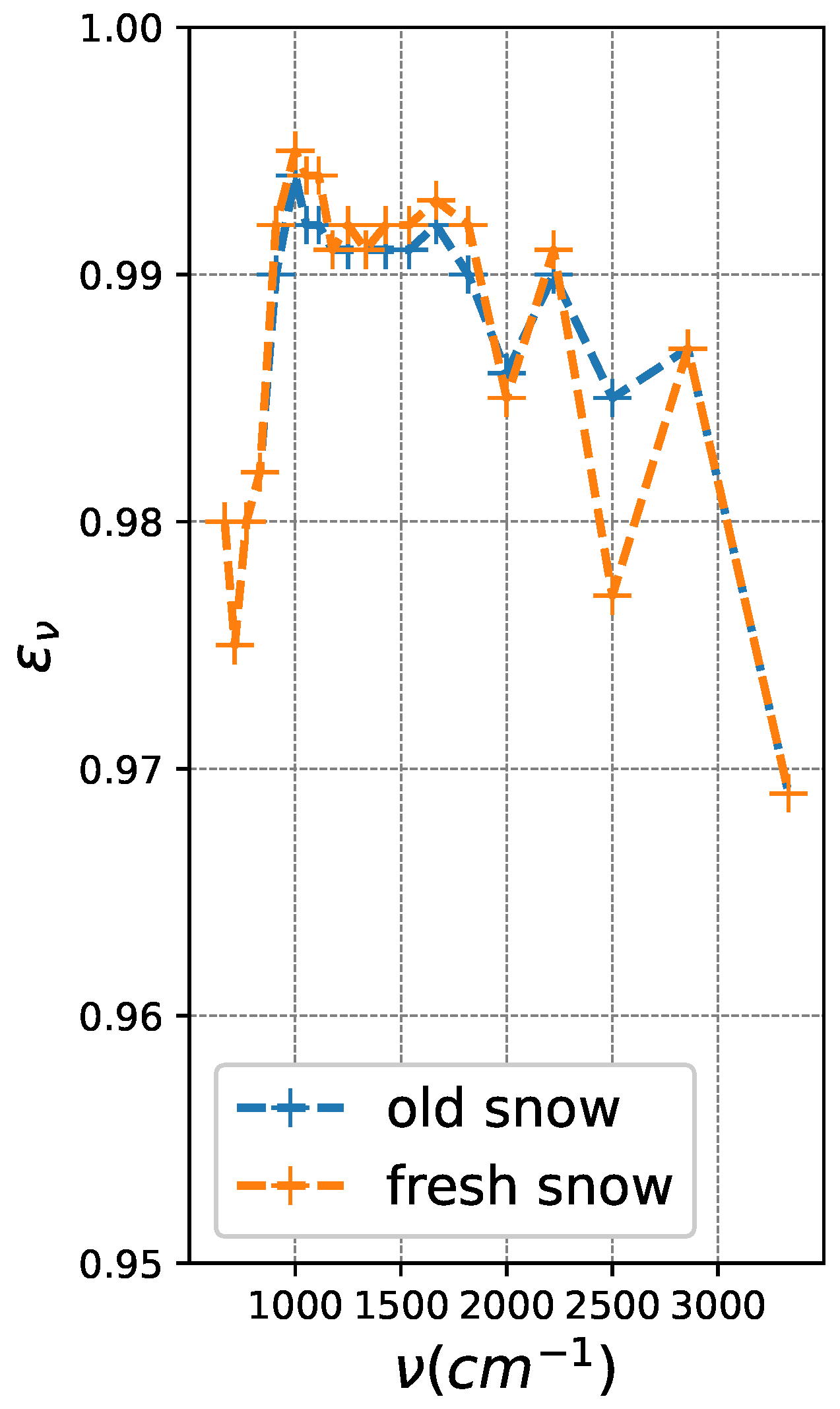
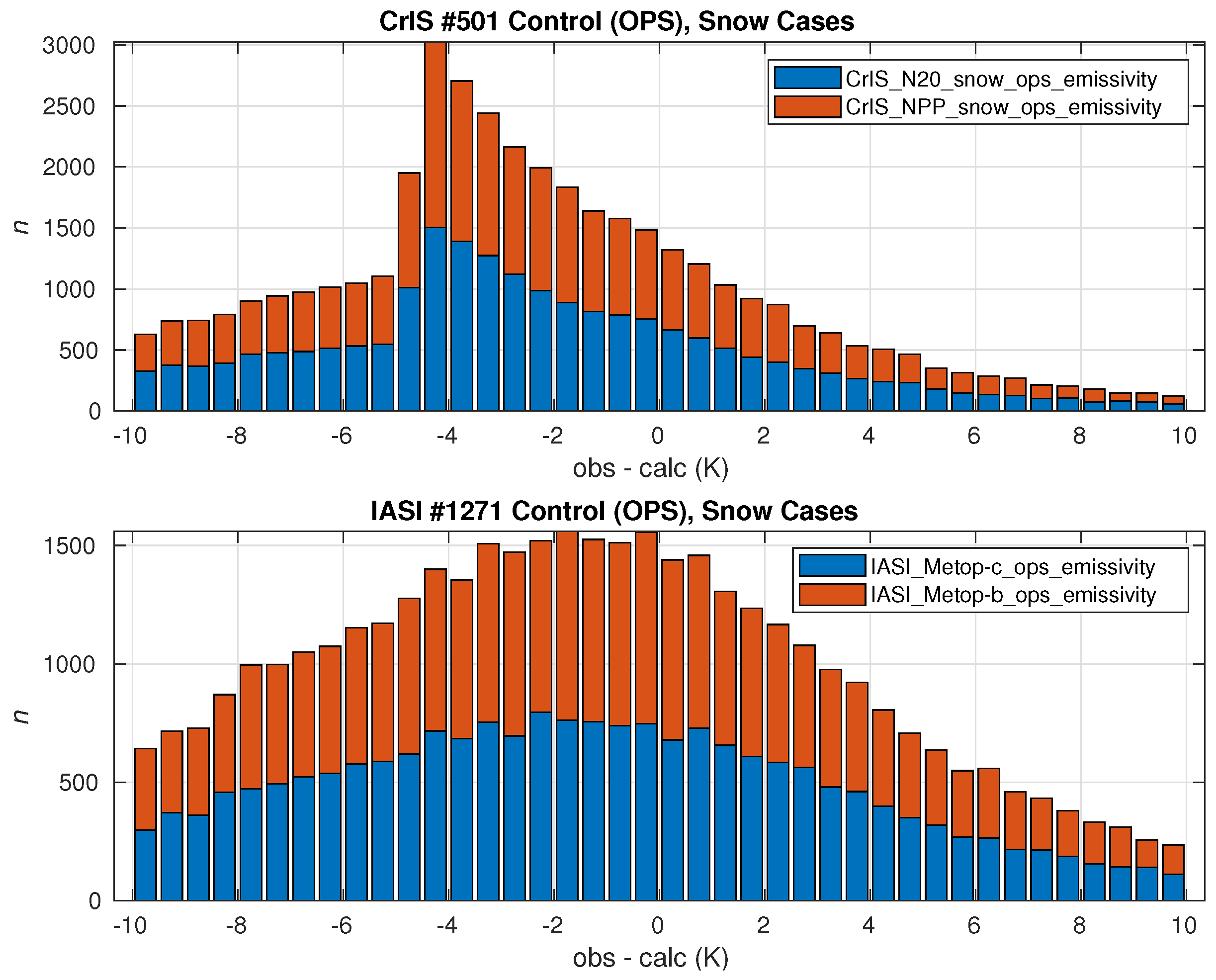
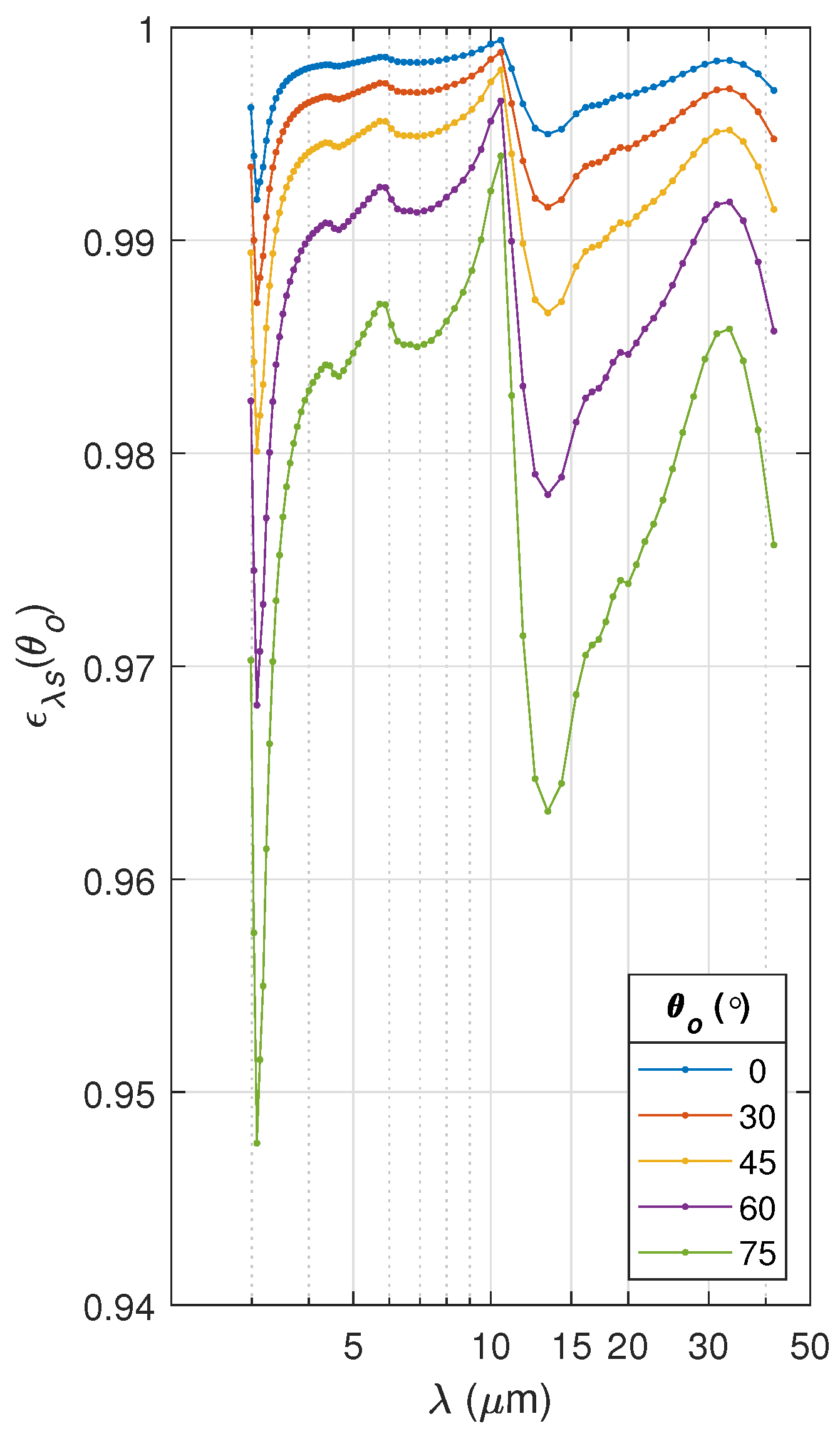
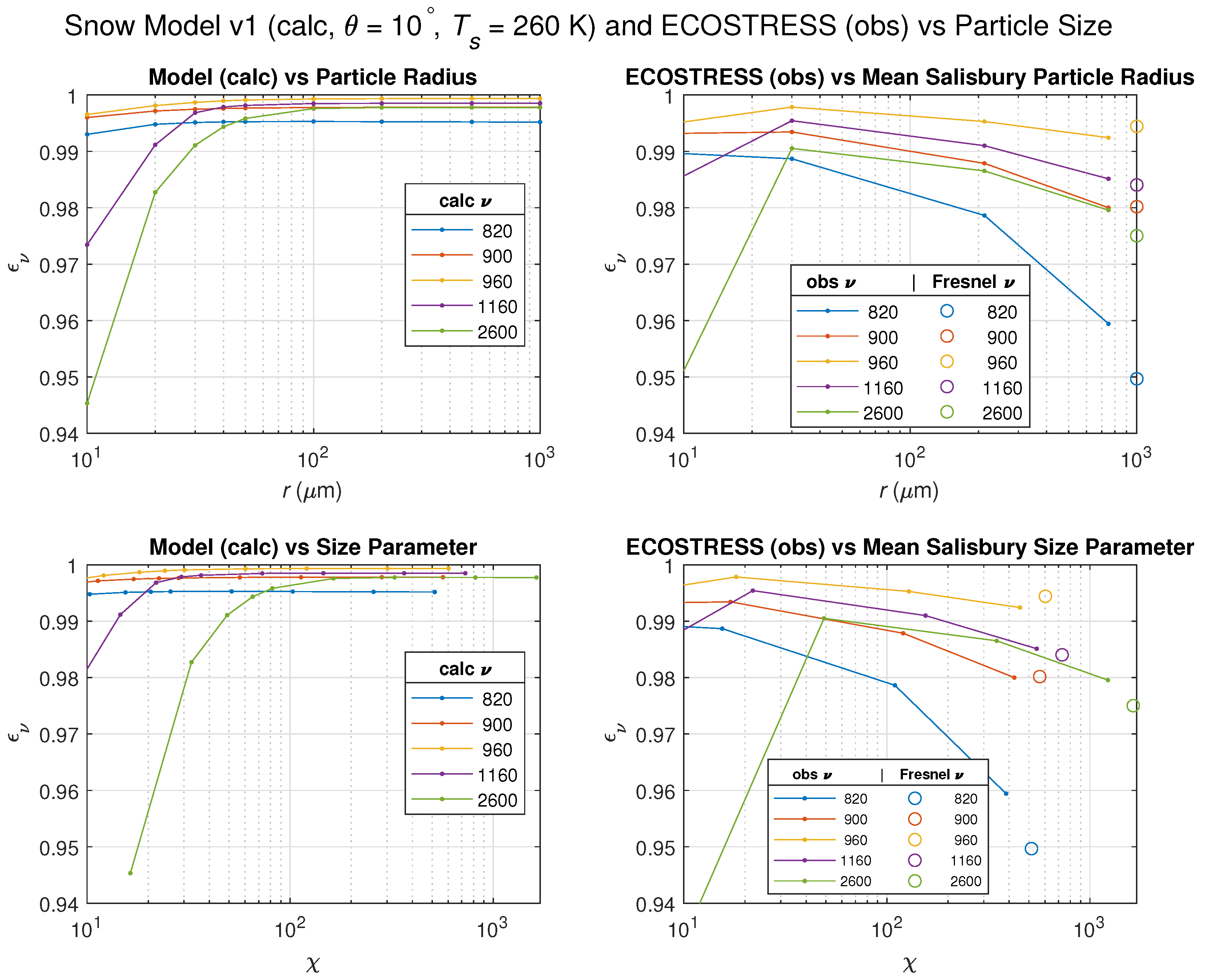
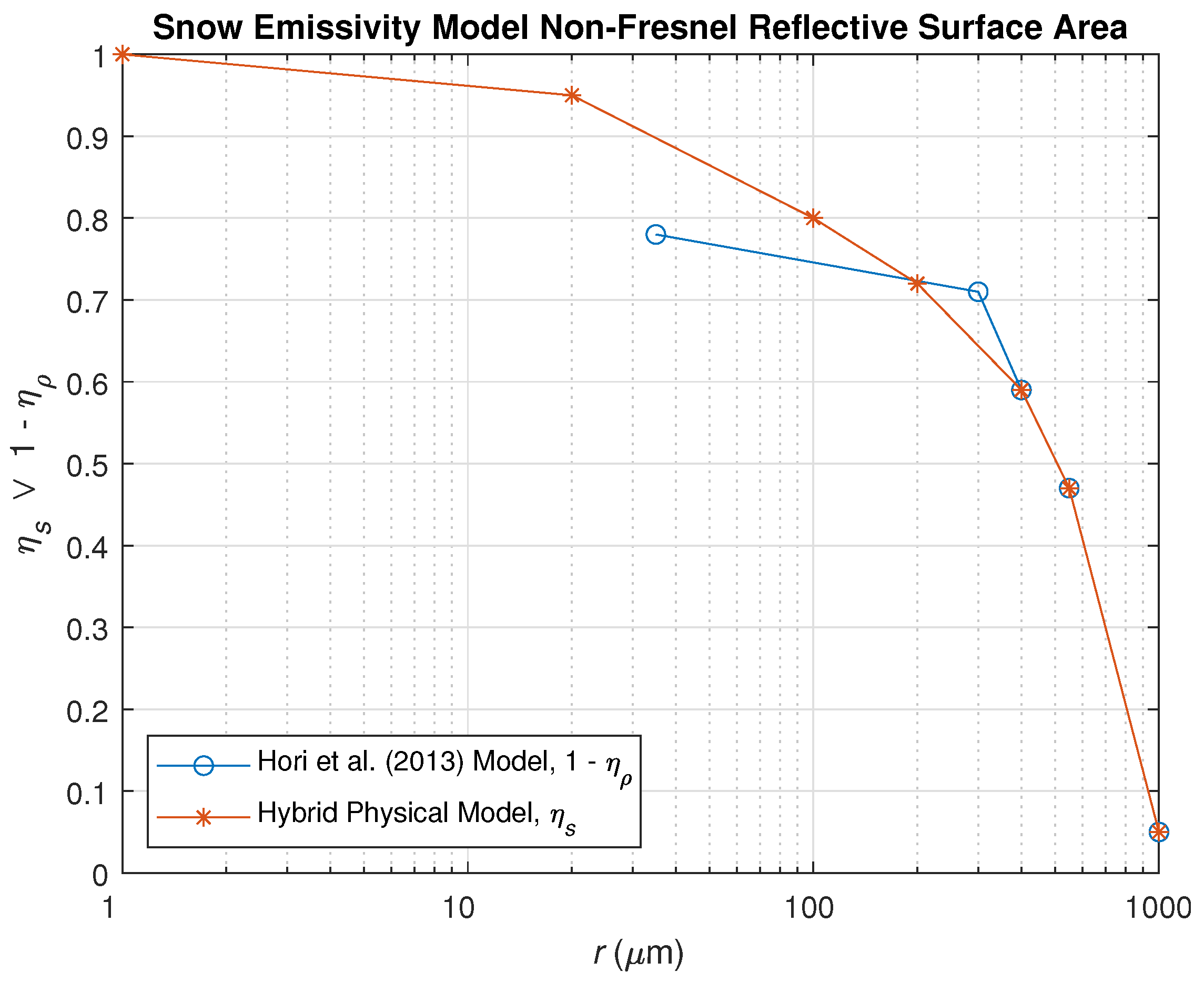
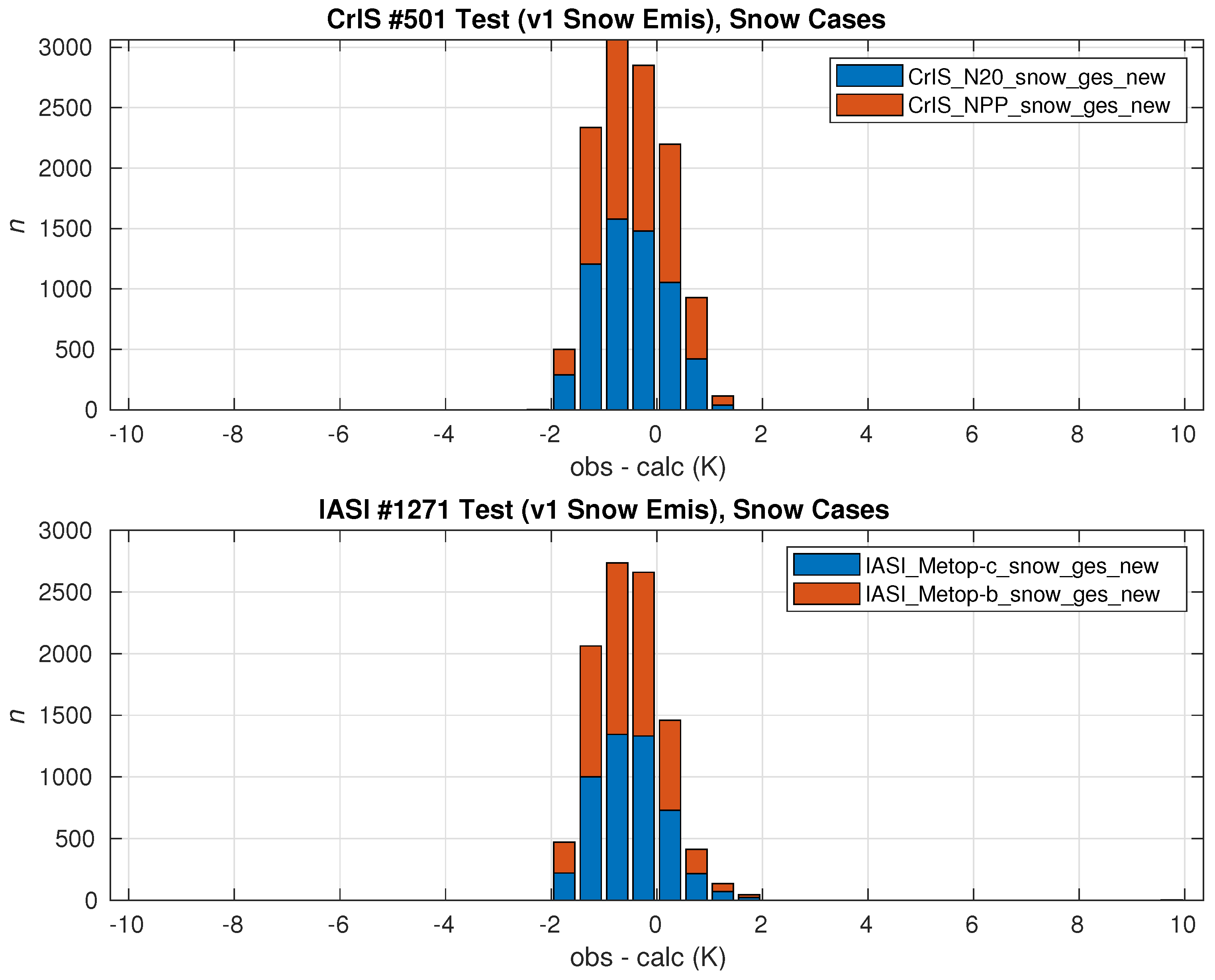


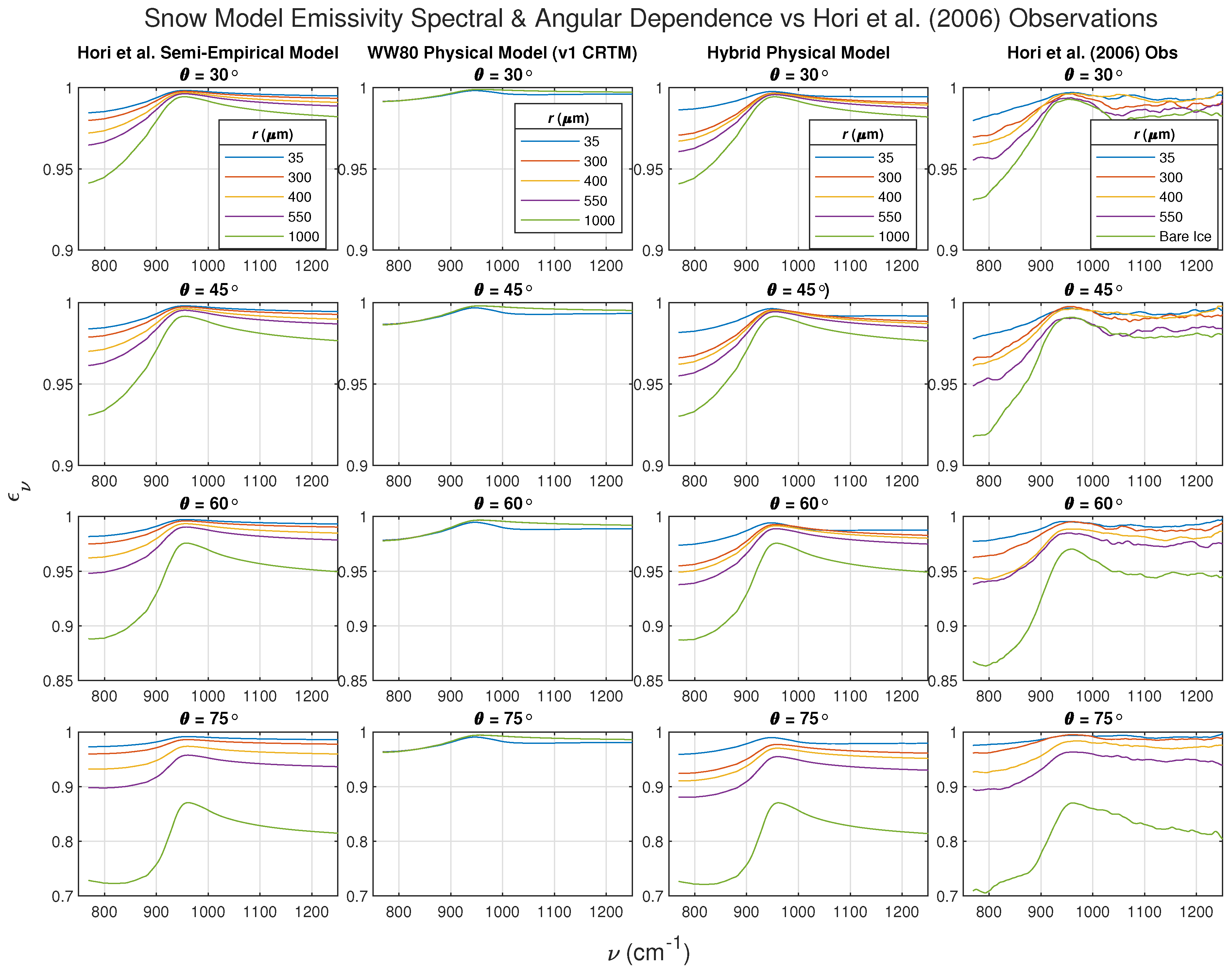
| # of Days after Snow Deposition | Mean Length (m) | Mean Radius (m) | Mean Constriction (m) |
|---|---|---|---|
| 1 | 200 | 45 | 50 |
| 5 | 190 | 45 | 50 |
| 9 | 260 | 60 | 80 |
| 15 | 430 | 80 | 100 |
| 24 | 600 | 110 | 140 |
| 31 | 570 | 130 | 160 |
| Particle Size, r (m) | Snow Morphology | ||
|---|---|---|---|
| Median | Range | ||
| 35 | 20–50 | 0.22 | fine dendrite snow |
| 300 | 150–550 | 0.29 | medium granular snow |
| 400 | 25–500 | 0.41 | coarse-grained snow |
| 550 | 400–750 | 0.53 | sun crust |
| ≳1000 (flat) | 0.95 | bare ice | |
| Model | (cm) | Grain Size, r | T (K) | |
|---|---|---|---|---|
| Original CRTM a priori | N/A | 666–3333 | “fresh” and “aged” | N/A |
| (CRTM release versions v1.0 to v2.3.0) | ||||
| WW80 physical model | 0–75 | 600–3000 | 5–1000 m | 230–270 |
| (CRTM v3, snow emissivity v1.0) | ||||
| Hybrid physical model | 0–75 | 50–3000 | 1–1000 m | 230–270 |
| (CRTM v3, snow/ice emissivity v1.1) |
Disclaimer/Publisher’s Note: The statements, opinions and data contained in all publications are solely those of the individual author(s) and contributor(s) and not of MDPI and/or the editor(s). MDPI and/or the editor(s) disclaim responsibility for any injury to people or property resulting from any ideas, methods, instructions or products referred to in the content. |
© 2023 by the authors. Licensee MDPI, Basel, Switzerland. This article is an open access article distributed under the terms and conditions of the Creative Commons Attribution (CC BY) license (https://creativecommons.org/licenses/by/4.0/).
Share and Cite
Nalli, N.R.; Dang, C.; Jung, J.A.; Knuteson, R.O.; Borbas, E.E.; Johnson, B.T.; Pryor, K.; Zhou, L. Physically Based Thermal Infrared Snow/Ice Surface Emissivity for Fast Radiative Transfer Models. Remote Sens. 2023, 15, 5509. https://doi.org/10.3390/rs15235509
Nalli NR, Dang C, Jung JA, Knuteson RO, Borbas EE, Johnson BT, Pryor K, Zhou L. Physically Based Thermal Infrared Snow/Ice Surface Emissivity for Fast Radiative Transfer Models. Remote Sensing. 2023; 15(23):5509. https://doi.org/10.3390/rs15235509
Chicago/Turabian StyleNalli, Nicholas R., Cheng Dang, James A. Jung, Robert O. Knuteson, E. Eva Borbas, Benjamin T. Johnson, Ken Pryor, and Lihang Zhou. 2023. "Physically Based Thermal Infrared Snow/Ice Surface Emissivity for Fast Radiative Transfer Models" Remote Sensing 15, no. 23: 5509. https://doi.org/10.3390/rs15235509
APA StyleNalli, N. R., Dang, C., Jung, J. A., Knuteson, R. O., Borbas, E. E., Johnson, B. T., Pryor, K., & Zhou, L. (2023). Physically Based Thermal Infrared Snow/Ice Surface Emissivity for Fast Radiative Transfer Models. Remote Sensing, 15(23), 5509. https://doi.org/10.3390/rs15235509














